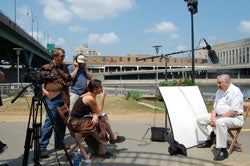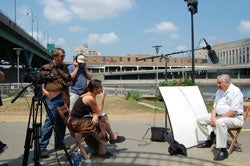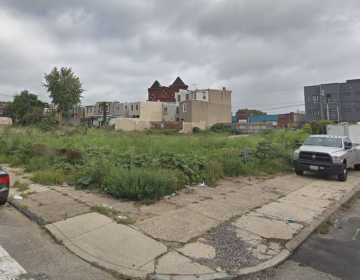Schuylkill River Park film unveiled


Councilman Jack Kelly is interviewed for the documentary
Photo courtesy of the Schuylkill River Park Alliance
March 30, 2009
By Thomas J. Walsh
For PlanPhilly
While the Delaware River waterfront gets most of the ink these days, actual or electronic, thousands of Philadelphians are enjoying a whole new part of the Schuylkill River bank, thanks in large part to a four-year effort by citizens and neighbors intent on using a newly greened recreation space on the lower part of the river in Center City. It’s on land that was once one of the city’s most heavily industrialized tracts.
On Sunday evening, a 15-minute film about the four-year struggle, “Free the River Park: The Story of Citizen’s Fight for Access to the Schuylkill River Park,” was screened at the Philadelphia Film Festival and CineFest. It was one of four short films shown in one presentation at the International House in West Philadelphia.
In the 1990s, neighbors organized for the new river trail, and raised $14 million. But heavyweight freight line CSX then restricted access to crossings, and it was ordered that a new park would have to be fenced off from adjoining neighborhoods. CSX was accused of even parking its enormous trains at strategic spots to show who was boss, one of the film’s 15 or so interviewees said.
Things got ugly. The neighbors became known collectively as Free The River Park, and embarked on a tenacious fight with the railroad.
“They filed a lawsuit, we put up some Web cams, and a lot of people got engaged really very strategically, and Philadelphia came together in a way that sometimes it doesn’t,” said Rob Stuart, executive producer and co-director of the movie and a Logan Square activist, during a Q&A session after the screenings.
During the battle, the organization even had laptops in lieu of clipboards for petitions. People using the trail signed electronically, online, on site. Demonstrations and massive public outreach ensued. Lawsuits bogged things down.
After some defiant CSX no-shows at Council hearings on the subject, city officials, including then-Mayor John Street and then-Councilman Michael Nutter, started to back the group more forcefully.
“We really had to put a lot of pressure on CSX, to show them how important this park meant to all of us,” said City Councilman at-large Jack Kelly, quoted in the film.
In 2007, the group prevailed, with CSX agreeing to provide at-grade crossings and other improvements. The company is now a partner with the group, which has renamed itself the Schuylkill River Park Alliance.
A representative of CSX was present at a ceremony that year with Mayor Street, which is shown in the film. On the company’s Web site, CSX says that through a “positive messaging” campaign called “Keep On Living,” the company “sought to incorporate safety into the culture and fabric of Schuylkill River Park, to demonstrate that CSX understands the importance of the park to the community and to establish CSX as a partner and supporter of the park and its mission. … Community groups embraced the campaign, including the organization that had been lobbying for CSX to do something about the problem.”
“I think it boosts the importance of civic groups all across the city of Philadelphia,” said Nutter. “This one example of a positive outcome for a situation that started out in a pretty negative way.”
Joggers, bikers, kayakers and fishers now frequent the park, and what was not long ago a dangerous stretch of the Schuylkill is now a well lighted, landscaped family gathering spot. The quality of life in adjacent neighborhoods jumped.
Next up for “The Hidden River”

The film is about the fight, but the alliance and other river groups are moving forward with other goals. The Schuylkill River Development Corp. “has unveiled the conceptual design of the boardwalk it plans to build between Locust Street and the South Street Bridge,” according to the Alliance Web site, where you can see a slide show of a Nov. 17 presentation. The boardwalk, extending 50 feet into the river, would have a concrete surface, 15 feet wide and four to nine feet high off the water, depending on the tide.
The SRDC has so far raised $4 million of the $10 million needed for construction.
There are bigger plans in the works, too.
“They have set their sites on creating the region’s first green transportation corridor,” said Stuart. “There are several sections of the park starting in the Southwest … to Fort Mifflin, and then our little piece where the park ends now, at Locust Street, down to South Street, then all the way down to Bartram’s Garden. Going north, there are pieces that are missing around Manayunk and into Montgomery County.
“All together it’s eight sections, it would be $20 million and we think there would be a whole lot of people that would benefit if we can get these projects funded within the next year, with the next [federal] transportation bill.”
A world away
The longest of the four films was “Poet of Poverty,” a grim but moving portrait of the small city across the Delaware, Camden.
It focuses on the letters and writings of an Irish priest seemingly straight from central casting – Father Michael Doyle, who has been at the center of Camden’s Sacred Heart parish since 1968.
The actor Martin Sheen narrates the film, quoting the priest’s angry but insightful calls to action with a driving, forceful voice. With Doyle’s tempered rage tossed in, the pulse quickens. Sheen reads some of Doyle’s poems, too, all Irish umbrage, emotionally raw, stirring. When matched with a plethora of images of decaying houses and streets, rampant drugs, open prostitution and intentional pollution, it produces a heartbreaking montage.
Doyle charges a willful, not benign, neglect on the part of county, state and federal authorities. All of Camden County, which includes upscale, sprawling suburban areas such as Cherry Hill, not only flushes their toilets directly to a sewage treatment plant near his church, but all the county’s trash and garbage ends up there, too. The result is a stench you can practically smell through the screen.
But perhaps worst of all for Doyle is the 20 or so scrap yards, big and small, that operate in Camden, many of which freely accept what are obviously stolen materials. Most of the countless abandoned homes in the city are stripped of everything but their walls and foundations, their insides long since wheeled down to the scrap yards.
Some of the mountains of scrap were visible in video shown of one of the city’s few smiling ribbon-cutting moments. After the earlier showing of the Schuylkill River group’s efforts, it was poignant that this moment of sunshine was also centered on the river – the Delaware, where a new fishing pier was opened.
From the film’s Web site:
The letter that begins the film was written in the aftermath of the terrorist attacks of Sept. 11, 2001, and accompanies the image of a child walking past boarded-up buildings and trash-filled streets on his way to school.
“A seventh grade boy in Sacred Heart School made this comment after the frightening destruction of the twin towers in New York that killed 2,700 people. ‘I feel safe here,’ he said. It was an amazing statement because most people are shocked in their shoes and scared to death. ‘You’re not afraid,’ he was asked. ‘No,’ he said. ‘I’m not afraid because if the terrorists fly over Camden, they’ll think they have done it already.’”
ON THE WEB:
Schuylkill River Park Alliance:
http://www.riverparkalliance.org/drupal/
http://www.freetheriverpark.info/
Schuylkill River National & State Heritage Area: http://www.schuylkillriver.org/
The film’s Facebook page: http://www.facebook.com/event.php?eid=72448562928&ref=mf
CSX: http://www.csx.com/?fuseaction=kol.safety_campaigns_community_detail&i=49753 )
“Poet of Poverty:”
http://poetofpoverty.com/
http://www.phillycinefest.com/film-details.cfm?id=8702
Contact the reporter at thomaswalsh1@gmail.com.
WHYY is your source for fact-based, in-depth journalism and information. As a nonprofit organization, we rely on financial support from readers like you. Please give today.




